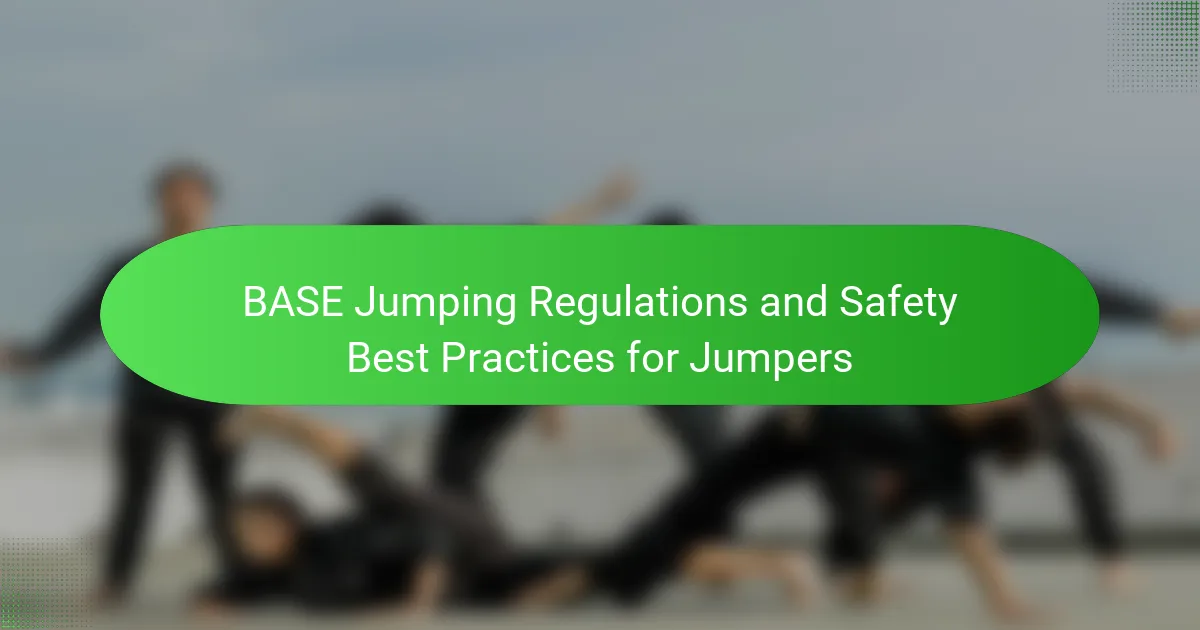BASE jumping presents exhilarating opportunities but also significant risks that require strict adherence to regulations and safety best practices. This article explores the varying regulations across regions, essential safety measures for jumpers, and the importance of training and certifications. It also addresses common risks associated with BASE jumping and offers insights into urban jumping considerations and technological advancements that enhance safety. Understanding these elements is crucial for a responsible and safe BASE jumping experience.

What are the key regulations governing BASE jumping in various regions?
BASE jumping regulations vary significantly across regions, with specific laws governing jump sites, safety gear, and permits. In the United Kingdom, for example, regulations differ by area, with some locations requiring permits for jumps and others having no restrictions. European countries often have stricter regulations, focusing on safety protocols and designated jump zones. In Australia, BASE jumping is generally regulated under aviation laws, requiring jumpers to adhere to specific safety standards. Understanding these regulations is crucial for safe participation in BASE jumping activities.
How do local laws impact BASE jumping activities?
Local laws significantly influence BASE jumping activities by dictating where and how jumpers can engage in the sport. Regulations vary widely, affecting jump sites, required permits, and safety protocols. For instance, some areas may prohibit jumping entirely, while others may have designated zones with specific rules. Compliance with these regulations ensures safety and minimizes legal risks for jumpers. Additionally, understanding local laws helps jumpers plan their activities effectively, ensuring they respect property rights and public safety.
What are the penalties for non-compliance with BASE jumping regulations?
Penalties for non-compliance with BASE jumping regulations can include fines, legal action, and potential imprisonment. Violating safety protocols can also lead to injuries or fatalities, emphasizing the importance of adherence. Regulatory bodies enforce these penalties to ensure the safety of jumpers and the public. Specific consequences vary by location and severity of the violation.
Which organizations oversee BASE jumping regulations?
The organizations overseeing BASE jumping regulations include the British Parachute Association (BPA), the United States Parachute Association (USPA), and the International Parachuting Commission (IPC). These entities establish safety standards and guidelines for jumpers. The BPA focuses on promoting safety and education, while the USPA provides resources for jumpers in the US. The IPC coordinates international rules and competitions, ensuring consistency across nations. Each organization plays a crucial role in enhancing safety practices within the BASE jumping community.

How can jumpers ensure safety during BASE jumps?
Jumpers can ensure safety during BASE jumps by following strict regulations and best practices. Key safety measures include thorough equipment checks, understanding jump sites, and adhering to weather conditions.
1. Conduct a pre-jump equipment inspection to ensure all gear functions correctly.
2. Familiarize yourself with the jump site, including exit points and landing zones.
3. Monitor weather conditions closely to avoid dangerous situations.
4. Jump with experienced partners to enhance safety through teamwork.
5. Participate in training programs to improve skills and knowledge.
6. Follow local regulations and guidelines to maintain compliance and safety.
These practices help mitigate risks associated with BASE jumping.
What are the essential safety gear requirements for BASE jumpers?
BASE jumpers must wear a helmet, an appropriate jumpsuit, a parachute system, and an automatic activation device. These safety gear requirements ensure protection during jumps. Helmets protect the head from impacts, while jumpsuits reduce drag. The parachute system includes a main and reserve parachute for controlled descent. An automatic activation device opens the reserve parachute if the jumper fails to deploy it manually. Compliance with these essentials enhances safety and minimizes risks associated with BASE jumping.
How does weather affect BASE jumping safety?
Weather significantly impacts BASE jumping safety by influencing conditions such as wind speed, visibility, and precipitation. High winds can lead to erratic canopy control, while low visibility can hinder landing accuracy. Rain or snow can affect surface conditions and increase the risk of accidents. Jumpers should always assess weather forecasts and conditions before attempting a jump to ensure safety. Factors like temperature and humidity can also affect equipment performance, making pre-jump checks essential.
What are the best practices for jump site selection?
The best practices for jump site selection prioritize safety, accessibility, and environmental considerations. Choose locations with favorable weather conditions, ample landing zones, and minimal obstacles. Assess the site’s legal status to ensure compliance with local regulations. Evaluate the terrain for potential hazards and consider the availability of emergency services nearby. Prioritize sites that have been vetted by experienced jumpers for reliability.

What training and certification are recommended for BASE jumpers?
BASE jumpers should pursue training from recognized organizations and obtain certifications to ensure safety. Recommended training includes courses on parachute packing, emergency procedures, and specific BASE jumping techniques. Certifications from reputable bodies, such as the British Parachute Association, validate skills and knowledge. Practical experience under the guidance of seasoned jumpers is crucial for mastering safety protocols and regulations.
Which training programs are recognized internationally?
Several internationally recognized training programs exist for BASE jumping, ensuring safety and regulatory compliance. Programs include the BPA (British Parachute Association) courses, the USPA (United States Parachute Association) training, and the BASE Jumping International Association’s certification. These programs emphasize safety best practices, risk management, and skill development. Each program is tailored to meet specific regulatory standards across different countries, enhancing global recognition and safety in the sport.
How do certification levels vary across regions?
Certification levels for BASE jumping vary significantly across regions due to differing regulations and safety standards. In the United Kingdom, for example, jumpers often rely on the British Parachute Association guidelines, while European countries may follow the European Union’s safety directives. Regions with established BASE jumping communities typically have more structured certification processes, while areas with fewer jumpers might lack formal certification altogether. This inconsistency can impact safety practices and jumper preparedness, emphasizing the importance of understanding local regulations before jumping.

What are the common risks associated with BASE jumping?
BASE jumping carries several common risks including equipment failure, environmental hazards, and human error. These factors can lead to serious injuries or fatalities.
1. Equipment failure: Parachute malfunctions can occur due to improper packing or damage.
2. Environmental hazards: Wind conditions and obstacles like buildings or trees pose significant risks.
3. Human error: Poor judgment in jump planning or execution can lead to accidents.
4. Inexperience: Novice jumpers may underestimate risks, increasing the likelihood of mishaps.
5. Legal issues: Jumping in restricted areas can result in fines or legal action.
Adhering to safety best practices and regulations can mitigate these risks effectively.
How can jumpers mitigate risks effectively?
Jumpers can mitigate risks effectively by adhering to established regulations and implementing safety best practices. Key strategies include thorough pre-jump assessments, using reliable gear, and maintaining communication with jump partners. Regular training and awareness of weather conditions further enhance safety. Additionally, following local regulations ensures compliance and minimizes risks associated with BASE jumping.
What are the most frequent causes of accidents in BASE jumping?
The most frequent causes of accidents in BASE jumping include equipment failure, misjudgment of landing zones, and environmental factors. Equipment failure often stems from inadequate maintenance or malfunctioning gear. Misjudgment occurs when jumpers fail to assess the landing area properly, leading to collisions with obstacles. Environmental factors, such as wind conditions and weather changes, can also contribute significantly to accidents. Proper training and adherence to safety regulations can mitigate these risks.

What unique considerations apply to urban BASE jumping?
Urban BASE jumping requires specific considerations due to dense populations and structures. Jumpers must prioritize safety by adhering to local regulations and understanding the risks associated with urban environments. Factors such as building heights, crowd control, and escape routes significantly influence jump planning. Additionally, noise restrictions and potential legal repercussions can impact jump locations. Collaboration with local authorities enhances safety and compliance, ensuring a responsible approach to urban BASE jumping.
How do building regulations affect urban jumps?
Building regulations significantly impact urban jumps by establishing safety standards and legal frameworks. These regulations dictate where and how BASE jumping can occur, ensuring the safety of jumpers and the public. Compliance with local laws is crucial for risk management and avoiding legal repercussions. Additionally, regulations may limit jump sites based on height, proximity to populated areas, and environmental considerations. Adhering to these guidelines enhances the overall safety of the sport while fostering responsible practices among jumpers.
What are the safety challenges specific to urban environments?
Urban environments present unique safety challenges for BASE jumping due to dense populations and infrastructure. Jumpers face risks from obstacles like buildings, power lines, and traffic. Regulations often limit jump sites to minimize hazards, requiring jumpers to assess conditions carefully. Additionally, urban noise can mask important auditory cues, complicating situational awareness. Effective communication with local authorities is crucial to ensure compliance and safety.

What innovations are improving safety in BASE jumping?
Innovations in technology and training are significantly enhancing safety in BASE jumping. Advanced parachute designs, such as wingsuits with improved stability, allow for better control during descent. Additionally, real-time tracking devices enable jumpers to monitor their altitude and location, increasing situational awareness. Training programs now emphasize risk assessment and emergency procedures, fostering a culture of safety among jumpers. Furthermore, community-driven safety initiatives encourage sharing experiences and best practices, contributing to collective knowledge and improved safety standards.
How are technology and equipment advancements changing the sport?
Advancements in technology and equipment significantly enhance safety and performance in BASE jumping. Innovations in gear, such as wingsuits and parachutes, improve aerodynamics and control. Enhanced materials increase durability and reduce weight, making jumps safer. Additionally, advanced training tools, like simulators and video analysis, help jumpers refine their skills. These developments contribute to stricter regulations and best practices, ensuring a safer experience for all participants.
What role do community forums play in sharing safety practices?
Community forums are vital for sharing safety practices in BASE jumping. They facilitate the exchange of real-world experiences and insights among jumpers. Participants can discuss regulations, best practices, and safety gear, enhancing overall awareness. This collaborative environment fosters a culture of safety, enabling jumpers to learn from each other’s successes and mistakes. Furthermore, forums often highlight unique safety techniques that may not be widely known, contributing to a richer understanding of safe jumping practices.
What are the emerging trends in BASE jumping safety practices?
Emerging trends in BASE jumping safety practices focus on enhanced training, technology integration, and community engagement. Jumpers increasingly adopt advanced gear, such as automatic activation devices, which significantly reduce fatality rates. Training programs emphasize scenario-based simulations, preparing jumpers for emergencies. Additionally, online platforms facilitate knowledge sharing, fostering a culture of safety and awareness among jumpers. These practices reflect a commitment to minimizing risks while promoting the sport’s growth.

What are the most common mistakes made by novice jumpers?
Novice jumpers often make critical mistakes that jeopardize their safety. Common errors include inadequate gear checks, neglecting weather conditions, and insufficient training. Many beginners underestimate the importance of proper landing techniques, leading to injuries. Failing to communicate effectively with teammates can also result in dangerous situations. Lastly, some jumpers overlook local regulations, which can lead to legal issues.
How can jumpers avoid these mistakes?
Jumpers can avoid mistakes by adhering strictly to regulations and following safety best practices. Key practices include thorough pre-jump planning, proper equipment checks, and understanding local laws. Always ensure a reliable exit strategy and maintain communication with fellow jumpers. Training and experience are vital to prevent errors.
What lessons can experienced jumpers share with newcomers?
Experienced jumpers emphasize safety, proper training, and adherence to regulations for newcomers. They recommend understanding local laws and jump sites. Building skills progressively is crucial. Jumpers should prioritize equipment checks and emergency procedures. Mentorship from seasoned jumpers can enhance learning and safety awareness.
Which resources are available for continuous learning in BASE jumping?
Several resources are available for continuous learning in BASE jumping, focusing on regulations and safety practices. Online courses, instructional videos, and forums provide updated information. Books and manuals from experienced jumpers offer in-depth insights. Local BASE jumping clubs often host workshops and training sessions. Additionally, attending seminars and conferences helps jumpers stay informed about the latest safety standards and regulations.
